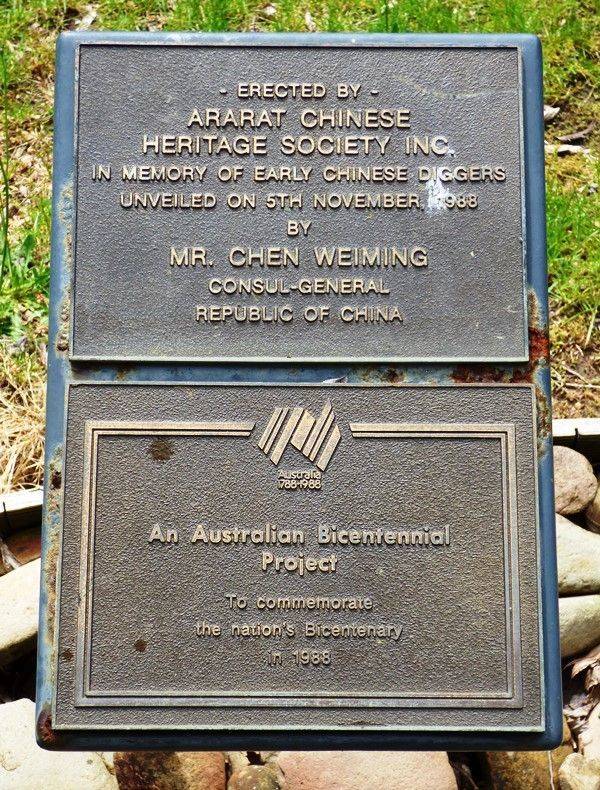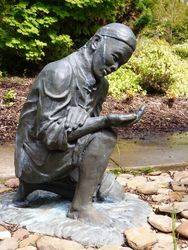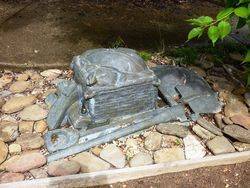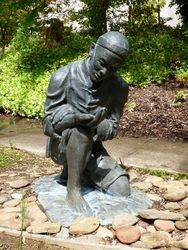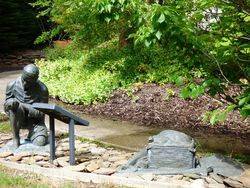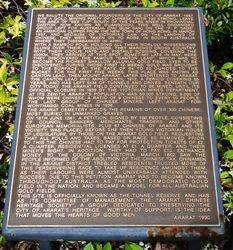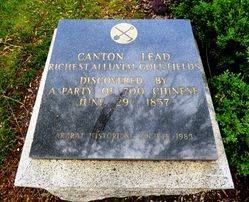
Home » Themes » Landscape » Settlement
Canton LeadPrint Page 
The sculpture commemorates the discovery of Canton Lead by the early Chinese gold miners. Thesculpture, in memory of the early Chinese diggers, was erected as an Australian Bicentennial Project and unveiled in 1988 and incorporates the plaque erected at the site of the Canton Lead mine by the Ararat Historical Society in 1985. In 1990, a further plaque was unveiled detailing the history of the site.
Canton Lead is unique in Australian cultural heritage and it is site upon which the city of Ararat was founded. Ararat is the only city in Australia to be founded by Chinese immigrants.
For the first five weeks it was referred to as Canton Lead, then as Mount Ararat, and then shortened to Ararat. On a Sunday morning in May, 1857, 700 Chinese miners from Southern China, travelling overland from the Port of Robe, South Australia, to the Clunes Goldfields in the Colony of Victoria, rested at a place at the foothills of the Great Dividing Range, some 400 kilometres due east of Robe.
Replenishing their water supplies at a spring, they discovered by chance the Canton Lead, the world`s richest shallow alluvial goldfield that stretched five kilometres at length. This find marked the beginning of the Ararat Goldfield, which grew to a population of more than 30,000 in a mere few weeks. In the first three months of mining, the Canton Lead yielded more than three tonnes of gold.
Location
| Address: | 31 - 33 Lambert Street (Western Highway) , Gum San Chinese Heritage Centre, Ararat, 3377 |
|---|---|
| State: | VIC |
| Area: | AUS |
| GPS Coordinates: | Lat: -37.279209 Long: 142.925455 Note: GPS Coordinates are approximate. |
Details
| Monument Type: | Sculpture |
|---|---|
| Monument Theme: | Landscape |
| Sub-Theme: | Settlement |
| Approx. Event Start Date: | May-1857 |
| Approx. Event End Date: | May-1857 |
| Artist: | Mrs Dorothea Saarghy |
Dedication
| Actual Monument Dedication Date: | Saturday 5th November, 1988 |
|---|
Plaque :
Erected by Ararat Chinese Heritage Society Inc.
In memory of early Chinese diggers
Unveiled on 5th November 1988 by Mr. Chen Weiming Consul-General Republic of China
Plaque :
Australia
1788 - 1988
An Australian Bicentennial Project to commemorate the nations Bicentenary in 1988
Canton Lead
Richest alluvial goldfields discovered by a party of 700 Chinese
June 29th 1857
Ararat Historical Society 1985
We salute the original founders of the City of Ararat. 1857 saw a gold mining party of Chinese, over 700 strong, leave the area of "See Yup" south of the Pearl River in provincial Canton, now known as Guangzhou. This well organised group left for Australia (Dai Gum San) of the "F. P. Sage" an American clipper from the new town of Hong Kong, In March 1857, and because of Victoria's law on the landing of Chinese, they were taken to Robe, in South Australia where they disembarked in April.
With a bamboo pole, holding all their worldly possessions slung over their shoulders, they marched cross country, with their coolie hats and pigtails bobbing, covering the 400km, they arrived at this spot, sometime late in May. Here they discovered the famous "Canton Lead", which was to become the richest shallow alluvial gold field, ever to be discovered. During those first 12 weeks, gold was brought to the surface, at a rate of 64 to 80 ounces to the bucket. For the first five weeks, this place was known as Canton Lead, then Mount Ararat, later shortened to Ararat.
The Canton Lead was mined until 1912, a period covering 55 years, and has left 5km of tunnels and drives, beneath our city today. The Ararat field continued to be mined, until its official closure in 1939 by the Victorian Mines Department. At its zenith, Ararat`s population was 50,000 strong, 9,000 of whom were Chinese, a ratio of 9 Chinese to every 50 people. The last group of Chinese miners, left Ararat for Wonthaggi coal mines in 1926.
The Ararat Cemetery holds the remains of over 300 Chinese, most buried in unmarked graves. On 18th June 1861, a petition, signed by 100 people, consisting of council, bankers, merchants, traders and other European memorialists, plus 67 Chinese, of Ararat and its vicinity, was placed before the then young Victorian House of Legislature, by those on the Ararat gold field, requesting that all polls and taxes, based on race, be removed.
Prior to this the Chinese had to pay for protection tickets of £2. a quarter, residential licences at £1. a quarter, and their miner`s right. In addition, they had to pay £10, entrance money to the colony of Victoria. March 1862 saw the people informed of the abolition of the Chinese Tax. Chinamen in the Ararat District trebled. Residents trusted more of this perservering (sic) race to take up residence amongst them, as the labours were almost universally attended with success. Due to this petition, Ararat was to become known throughout Australia, as the most democratic gold field in the nation, and became a model for all Australian gold fields.


